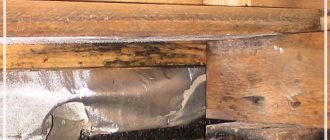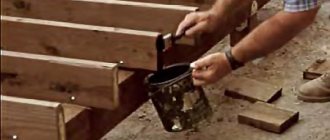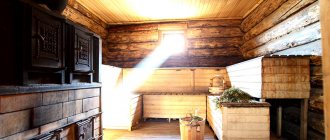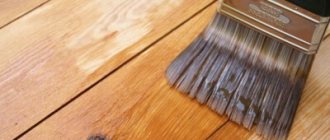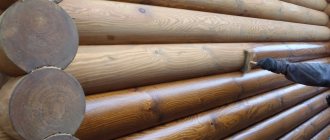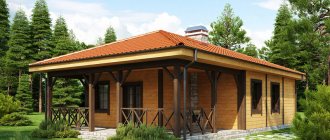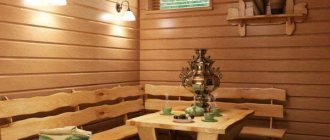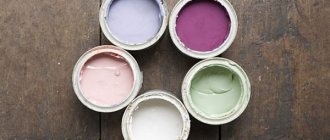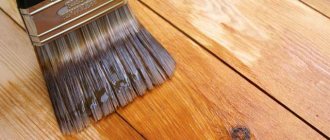Criterias of choice
For all its advantages, wood is susceptible to moisture. Over time, it dries out, darkens and begins to rot. Mold and microorganisms may appear on it. All this is true for normal external conditions. And in the steam room the conditions are extreme. Even in the dressing room there are no such impacts on the walls and floor. The influence of sudden changes in temperature and humidity in the steam room accelerates the destruction of wood. When exposed to high temperatures, conventional protective coatings can release harmful substances.
In addition, a steam room is not just a room in which a person is located. He remains there naked, his body in contact with wooden surfaces. And on some it even lies. This means that for shelves and benches you need to choose wood protection that will not be unpleasant upon contact.
Most often in the steam room they try to preserve the natural color of the wood, selecting species that look beautiful. But if you want to paint part of the steam room, then you need to take this into account when choosing an impregnation. Not every impregnation is suitable for subsequent painting.
Wood color after different impregnations Source elka-palka.ru
It is clear that it will not be possible to find the same impregnation for a bathhouse outside and inside. Even different parts of the steam room may require different protective equipment. Wood treatment in a steam room should be carried out with compounds adapted to its conditions. And the choice must be based on the following criteria:
- Which part of the steam room is the product intended for?
- Will it be primary impregnation of wood, or re-coating of a previously protected surface?
- Method of applying a protective substance to a wooden surface - with a brush, roller or spray
- Are there plans to further paint the impregnated wood?
Features of paint application
The surest way to paint is to apply the first layer. Then you should wait for it to dry completely and only then apply the next layer. The ends are painted more carefully - in 4 layers.
After applying the initial layer, if irregularities appear on the surface, they should be sanded. The area is then covered with at least two layers. Using a spray gun greatly simplifies and speeds up the painting process. There are devices designed specifically for water-soluble or alkyd compounds.
Using a spray gun greatly simplifies and speeds up the painting process.
Ceiling
Perhaps the least requirements are placed on this part of the steam room. It is exposed only to the temperature effects of steam. Water almost never reaches it. Therefore, it can simply be coated with a specialized bath varnish.
The ceiling in the bathhouse must be reliably protected from dampness and temperature Source eco-ceiling.ru
See also: Catalog of companies that specialize in paints and varnishes.
Floor
Unlike the ceiling, all the water that is used in the steam room ends up on the floor. Therefore, the anti-water protection for floor boards must be very good. In addition to antibacterial and anti-water impregnation, it is advisable to cover the floor with a protective layer of varnish. But not every varnish is suitable for the floor. The protective layer should not be slippery. This is a must to protect the floor. Of course, the soles of your feet should not stick to the floor. Do not think that repeatedly coating the floor with varnish increases its safety. The thick layer of varnish cracks and water reaches the wood. In addition, the wood cannot “breathe” through such a coating and will still deteriorate.
When building a bathhouse, do not forget about impregnating the logs on which the floor boards are laid. This, of course, is not the inside of the bathhouse, and there are no special protection requirements for them. But if water gets to them, then sooner or later the floor inside the bathhouse itself will suffer, no matter how well it is protected.
Walls
Most of the impregnation for the bathhouse inside is spent on protecting the lining, which is usually used to line the walls. Therefore, you should not use impregnations and varnishes that, when heated, can release strong-smelling substances. And do not cover it with a protective layer that does not allow the wood to “breathe.”
Improper use of protective compounds can lead to the regular appearance of condensation on the walls of the bath Source synteko.in.ua
Shelves and benches
The shelves are the main part of the entire steam room, for which it is, in fact, built. Lying on it should be comfortable, pleasant and safe for health. Wood is a poor heat conductor, so even at high temperatures you won’t get burned by it. It’s another matter if it is covered with a protective film, which can cause a burn if touched. Therefore, it is not recommended to use paints or varnishes for it. It is better to apply a special impregnation for the bath. Often such impregnations are wax-based.
The requirements for the safety and convenience of the surface of shelves and benches are so high that there are bathhouse lovers who believe that wood should be natural for them and not covered with anything at all. But this is still suitable for small bathhouses, where simple shelves can be replaced. And when real furniture masterpieces are built, it is better to find a high-quality composition and ensure their durability.
It’s not enough to create beauty – you also need to protect it Source m.yukle.mobi
Processing of a sauna log
The standard method of impregnation with an antiseptic involves working with a brush or spray. Working with a brush is more difficult and takes longer. However, it is indispensable in some cases, for example, when a certain area cannot be properly coated with a sprayer. Every 2-3 hours it is recommended to change the brush to a new one.
Impregnation with a spray gun is considered to be of higher quality and, which is absolutely certain, is carried out much faster.
In some cases, alternative methods of processing wooden structures are appropriate:
- Method of immersing wood in a container with an antiseptic agent. This approach guarantees impregnation of even the most difficult to reach areas of the structure.
- The diffuse (dry) method of treating with an antiseptic drug involves applying a paste or powder substance to the surface.
Before you begin to impregnate the log house, it must be cleared of all kinds of blockages. A vacuum cleaner is suitable for this purpose. Then the surface must be thoroughly dried.
The compositions are applied in the following sequence:
- means for protection against fungus and moisture;
- impregnation against insect pests;
- fire-fighting agent (fire retardant).
After finishing surface treatment with antiseptics, it is recommended to apply a gel or primer. However, we must not forget about the basic rule: the material must be breathable.
If everything is done in accordance with the technology, then subsequent impregnations are done no earlier than three years later. Some compositions last up to five years.
Processing of a log house begins with fire-retardant impregnation; fire retardants are used for this. A good option is to use Neomid 530, which is used as a reliable means against wood fire.
Although modern antiseptics can also protect wood from burning, so you can choose a universal option. They will protect your home from various fungi and insects. In addition, antiseptics repel moisture, so even with the initial treatment of a log house with an antiseptic, it will no longer be afraid of atmospheric phenomena.
For example, fire-retardant antiseptic impregnation Pirilax - Classic for wood. It will provide protection from fire, mold, blue stains, and insects. Paint and varnish coatings can be applied on top.
Among domestic manufacturers, the most popular antiseptic is Neomid 400, intended for use inside the house, it protects wood for up to 25 years. Environmentally friendly, specially designed for treating residential premises. For outdoor work you can use Neomid 440. But “Neomid 450” has additional fire protection.
And if you want to give your wood maximum protection, you can use Neomid 430, it is used for both external and internal work. It is even used to treat piers where wood is in direct contact with water. According to the instructions, increased protection will be provided for up to 35 years.
Among the imported options, you can choose Tikkurila Valtti Color, (Tikkurila Valtti Color Satin, Tikkurila Valtti Color Extra, Tikkurila Valtti Akvacolor) this is a glazing, colorable antiseptic produced by a Finnish company, it not only protects the wood but also gives a wonderful shade. The range of colors is very large.
Tikkurila Vinha – Covering semi-matte antiseptic that keeps the wood structure visible.
Tikkurila Valtti-Pohjuste is an antiseptic primer that protects wood and prepares it for painting.
If you want the structure of the wood to be visible, you can use a colorable antiseptic; it will give your log a wonderful shade. In the future, you can coat the frame with varnish. Well, if you paint the house, use an antiseptic primer, then the paint will adhere more reliably to the log.
For painting, it is better to use water-soluble dyes, then the wood will be able to breathe freely, and the paint and antiseptics will protect the wood from atmospheric agents. Tikkurila Ultra, which is used for painting external wooden surfaces, is well suited for these purposes.
Protective compounds and their properties
For the sake of order, it is necessary to mention such a remedy as drying oil, which used to cover all the insides in the bathhouse. It is still used today, but it should not be used in a steam room. It will be cheap, but cheerful. In terms of protective properties, this is yesterday, and the smell from it when heated well is not pleasant.
Water-dispersed impregnations
They are made on a water basis, so they penetrate deeply into the wood structure. They are resistant to high temperatures, do not contain active chemical components and do not emit any harmful compounds when heated. Modern water impregnations contain antibacterial components. Available both colorless and with added dyes.
The disadvantage is their fragility. Over time, under the influence of water, they are washed out of the wood, so the impregnation must be renewed every two years.
Oil impregnations and varnishes
They impregnate and protect wood well from moisture, forming a film. But their inherent smell is a significant drawback. Therefore, they must be used with caution in the steam room. They are quite suitable for external impregnation and for protecting wood in the dressing room.
The varnish preserves the appearance of the wood, giving it a mysterious shine Source freepatriot.club
Acrylic based varnishes
Acrylic varnish for baths inside is considered safe. A modern product made from polyacrylates and organic solvents. Environmentally friendly and more durable than conventional water-dispersed products. Acrylic varnishes produced for baths and saunas necessarily contain antifungal components.
Water-based polyurethane varnish
Combines the advantages of water-dispersed and alkyd varnishes. It appeared on the market relatively recently, so it should be treated with caution, as with any new product. And its price is quite high.
Wax-based impregnations
Wax, like drying oil, has long been used to protect and add shine to wooden surfaces. Nowadays purely wax impregnations are almost never used. It is common practice to add wax to protective products based on other components.
In addition to protective products, special detergents are also produced for cleaning and bleaching wood. They are used both before applying protection and for washing dirty and darkened surfaces.
How to update the lining
Over time, the appearance of untreated lining ceases to please the owners. Wood tends to darken from moisture, but there is also soot that eats into the wood. For those who are no longer satisfied with this state of affairs and have decided to update the lining in the bathhouse, we have found tips that will help cope with any problem.
How and with what to remove soot
When carbon is not completely burned in a furnace (completely is CO2 or CO), it is released as an amorphous substance that we call “soot.” Soot deposited on the walls is soot.
Cleaning the lining in a bathhouse from soot is more difficult than it seems at first glance. It eats firmly into the wood. And when you try to wash it with soap and a brush, cleansing does not happen.
There are two proven methods for removing soot - mechanical and chemical.
Mechanically, everything is clear - the contaminated surface must be scraped off using any available method. Either manually or using a power tool - the same grinder with an abrasive wheel. As a result, the top layer of wood is removed, revealing a clean surface, and the result is what you need.
The chemical method does not require physical effort and takes much less time. On sale you can find products that were developed specifically to eliminate soot or soot from a fire.
As an example, let's name SYNTILOR Fuoco, DOCKER MAZBIT PLUS, “Facade Cleaner No. 2” from and the like.
The video clearly shows how the first of these tools works:
But here’s what’s interesting: all compounds that remove soot and soot contain... alkali as the main active component. No one says the composition, but there are just one or two strong alkalis, and their qualities are approximately the same. We mean sodium and potassium hydroxides - KOH and NaOH.
There is nothing stopping you from buying them at a store cheaply, diluting them with water and washing off the soot from the wood.
VERY IMPORTANT! If you don’t want chemical burns, don’t even try to work with alkali without covering your arms and legs with clothing, gloves and glasses. Chemical burns are worse than thermal burns, or rather deeper. And keep an acid solution nearby - vinegar, dilute citric acid - so that you can immediately pour the place where the alkali got in. There is no use in rinsing with water!
After the soot disappears, be sure to wash off any remaining lye from the wall. We recommend doing this first with an acid solution (vinegar, lemon) so that the residues are neutralized, and then with clean water.
There is another way, but we like it even less than dangerous alkali. We are talking about a mixture of gasoline and washing powder with water . You already have a fire-hazardous building with a stove; soaking it in gasoline seems unnecessary.
But if you need to wash, say, a fireplace brick , but there is no alkali on hand, you can mix two tablespoons of washing powder, 100 ml of water, 100 ml of gasoline, then vigorously shake the mixture in a bottle and start scrubbing.
In general, it is clear that soot and soot are removed by degreasers. Yes, by the way, burnt baking sheets are washed in the same way as lining - with alkalis.
How to wash the paneling
We have already recommended a way to get rid of blue stains and lighten darkened wood using bleach (by the way, this is just a solution of sodium hypochlorite, bleach - you can prepare it yourself from powder).
BY THE WAY! If someone starts complaining that chlorine vapor will continue to be inhaled for a long time, don’t believe it. Because the smell (and therefore the volatile substances) disappears quickly, and there is no more cause for concern than when working with “Whiteness” at home. But it’s better not to pour it on your hands, of course.
You can do without bleach altogether if you walk over the darkened lining with a sander.
If the task is to get rid of sweat, grease and the like, then it will be enough to wash the lining in a bathhouse with a strong solution of laundry soap . Moreover, what is interesting: laundry soap contains residues of alkali from the saponification of vegetable fat (that’s how it is obtained), so it is not neutral, but slightly alkaline. So it turns out that you are again using alkali, only weak.
Some people may find washing with soap a long time - then just increase the alkaline component. Following the safety precautions described above, of course! Maybe you have a “Mole” - breed it.
***
This is such a chemical and not only educational program. Like, share links with friends and subscribe to our channel in Telegram.
Protective products for baths from different manufacturers
When processing wood inside a steam room, you should not experiment too much. You need to choose varnishes and impregnations made specifically for baths and saunas. Those who produce such products take into account the conditions and requirements for such premises.
The Finnish company Tikkurila is considered the leader of such products.
- Supi Saunasuoja – water-based impregnation with acrylic. Suitable for temperatures above 100 °C. A universal product for internal protection of steam rooms. Available in both a colorless version and a form suitable for tinting.
Impregnation Supi Saunasuoja Source marketut.ru
- Supi Laudesuoja – oil impregnation suitable for covering shelves
- Supi Saunavaha is a wax-based varnish. It is also considered universal and suitable for any bath surfaces.
Imported compounds have one drawback - the price. Domestic manufacturers provide cheaper products. Here are some designed specifically for bath conditions:
- Senezh sauna is an acrylate-based antiseptic to protect wood in saunas. Contains antimicrobial agents but is odorless.
- NEOMID 200 – antiseptic for wooden bath surfaces, including shelves and benches.
- NEOMID Sauna is a translucent acrylic-based varnish. For protecting and finishing wood in rooms with high humidity.
NEOMID Sauna varnish for baths Source gros-stroi.ru
Reviews
Alena Ratnikova, 28 years old, Kazan.
Eurotex sauna varnish is a good composition. A year has passed since using this product and there are no complaints about it yet. I covered the wood with one layer in the steam room and two in the other rooms. When applying two layers of product without dilution, 2.5 kg was enough for the walls and ceiling of a steam room with a total area of 22 square meters. m and 2 doors. The second layer was applied 40 minutes after the first. This product is not suitable for shelves - they were covered with oil.
Alexander Pyatakov, 37 years old, St. Petersburg.
I consider Neomid acrylic varnish to be an excellent odorless composition. The composition is excellent for carrying out interior work in a bathhouse. Neomid makes the wooden surface matte. It is pleasant to work with and easy to apply to walls and ceilings. The composition is white, but after drying the wooden surface it becomes colorless. I store it in my apartment in a jar with a tightly closed lid. Good impregnation!
Recommended Posts
How to paint walls with water-based paint without streaks
Silver paint
Washable water-based wall paint
How to choose unscented bathroom paint
Pearlescent paint for walls + photo
Paint for walls in a children's room
How to get advice and consultation and buy a good means of protection? What do we recommend?
You can view and select the desired antiseptic here.
You can get professional advice on these antiseptic compounds from the honored worker in the field of wood protection from pests: Galina Nikolaevna Zelentsova by phone: +7 (905) 752-77-20.
If you have made a choice in favor of Neomid brand protective equipment, then you can buy them at retail for pickup from the city of Balashikha, here - Contacts.
place a small wholesale order of effective wood protection products with delivery by calling; ;.
